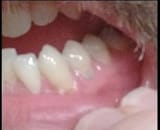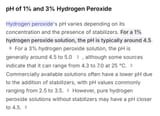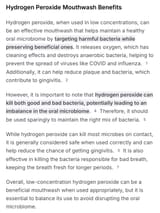>>507863952>1/2Hydrogen peroxide (H2O2) is a reactive oxygen species (ROS) that can be toxic to microorganisms due to its ability to generate hydroxyl radicals, which damage cellular components such as DNA, proteins, and lipids. However, when hydrogen peroxide is mixed with saline, the resulting solution can have a differential effect on various types of bacteria, preserving some while being more harmful to others. This is due to the interaction between hydrogen peroxide, saline, and the physiological characteristics of the bacteria.
At lower concentrations, hydrogen peroxide can be less toxic to certain bacteria, particularly those that have evolved mechanisms to tolerate or neutralize ROS. For example, some bacteria, such as Escherichia coli and Pseudomonas aeruginosa, possess regulatory systems like OxyR, which help them respond to and mitigate the effects of hydrogen peroxide. These bacteria can also produce enzymes such as catalase and peroxidase, which break down hydrogen peroxide into water and oxygen, reducing its toxic effects. In the presence of saline, which can influence the osmotic balance and cellular environment, these bacteria may be better able to survive and even thrive, as the saline may help stabilize their cellular structures and reduce the permeability of hydrogen peroxide to their cell membranes.
In contrast, anaerobic bacteria, which are typically sensitive to oxygen and its derivatives, are more vulnerable to hydrogen peroxide. These bacteria lack the enzymatic defenses necessary to neutralize ROS and are therefore more likely to be killed by even low concentrations of hydrogen peroxide. The presence of saline may not provide the same protective effect for these bacteria, as their metabolic processes are adapted to oxygen-free environments, and the introduction of hydrogen peroxide can disrupt their cellular functions.




















